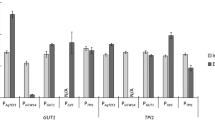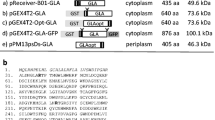Abstract
The copy number of a plasmid, pUC-based vector, was previously shown to be affected by culture temperature. In this study, intracellular hirudin variant 1 (f-HV1) fused to porcine adenylate kinase protein was produced using recombinant Escherichia coli by temperature shift cultivation coupled with a high cell density cultivation technique for E. coli JM109. The optimal temperature for cellular growth suppressing f-HV1 production was 33°C, resulting in a final dried cell concentration of 45.7 g/l, with a specific growth rate of 0.54 1/h. Optimizing the temperature-shift conditions (temperature shifted to an OD660 nm of 15 from 33°C to 37°C) resulted in the production of f-HV1 up to 4763 mg/l as an inclusion body with dried cell concentration of 44 g/l in 18 h.


Similar content being viewed by others
References
Bergmann C, Dodt J, Kohler S, Fink E, Gassen HG (1986) Chemical synthesis and expression of a gene coding for hirudin, the thrombin-specific inhibitor from the leech Hirudo medicinalis. Biol Chem Hoppe Seyler 367:731–740
Bradford MM (1976) A rapid and sensitive method for the quantitation of microgram quantities of protein utilizing the principle of protein-dye binding. Anal Biochem 72:248–254
Choi CM, Kim MD, Rhee SK, Seo JH (1996) Effects of medium composition on hirudin production in recombinant Saccharomyces cerevisiae. Biotechnol Lett 18:1129–1132
Frey KM, Oppermann-Sanio FB, Schmidt H, Steinbuechel A (2002) Technical-scale production of cyanophycin with recombinant strains of Escherichia coli. Appl Environ Microbiol 68:3377–3384
Imanaka T, Aiba S (1981) A perspective on the application of genetic engineering: stability of recombinant plasmid. Ann N Y Acad Sci 369:1–14
Lin-Chao S, Chen WT, Wong TT (1992) High copy number of the pUC plasmid results from a Rom/Rop-suppressible point mutation in RNA II. Mol Microbiol 6:3385–3393
Matsui T, Yokota H, Sato S, Mukataka S, Takahashi J (1989) Pressurized culture of Escherichia coli for a high concentration. Agric Biol Chem 53:2115–2120
Matsui T, Sato H, Sato S, Mukataka S, Takahashi J (1990) Effects of nutritional conditions on plasmid stability and production of tryptophan synthase by a recombinant Escherichia coli. Agric Biol Chem 54:619–624
Matsui T, Shinzato N, Haruto Y, Takahashi J, Sato S (2006) High cell density cultivation of recombinant E. coli with a pressurized culture. Proc Biochem 41:920–924
Matsui T, Sato H, Yamamuro H, Misawa S, Shinzato N, Matsuda H, Takahashi J, Sato S (2008) High cell density cultivation of recombinant E. coli for hirudin variant 1 production. J Biotechnol 134:88–92
Mendoza-Vega O, Hebert C, Brown SW (1994) Production of recombinant hirudin by high cell density fed-batch cultivations of a Saccharomyces cerevisiae strain: physiological considerations during the bioprocess design. J Biotechnol 32:249–259
Murarka A, Dharmadi Y, Yazdani SS, Gonzalez R (2008) Fermentative utilization of glycerol by Escherichia coli and its implications for the production of fuels and chemicals. Appl Environ Microbiol 74:1124–1135
Nowak G (2002) Pharmacology of recombinant hirudin. Semin Thromb Hemost 28:415–424
Phue JN, Shiloach J (2004) Transcription levels of key metabolic genes are the cause for different glucose utilization pathways in E. coli B (BL21) and E. coli K (JM109). J Biotechnol 109:21–30
Sambrook J, Fritsch EF, Maniatis T (1989) Molecular cloning: a Laboratory Manual, 2nd edn. Cold Spring Harbor, NY: Cold Spring Harbor Laboratory
Schmidt M, Viaplana E, Hoffmann F, Marten S, Villaverde A, Rinas U (1999) Secretion-dependent proteolysis of heterologous protein by recombinant Escherichia coli is connected to an increased activity of the energy-generating dissimilatory pathway. Biotechnol Bioeng 66:61–67
Shiloach J, Fass R (2005) Growing E. coli to high cell density—a historical perspective on method development. Biotechnol Adv 23:345–357
Tabandeh F, Shojaosadati SA, Zomorodipour A, Khodabandeh M, Sanati MH, Yakhchali B (2004) Heat-induced production of human growth hormone by high cell density cultivation of recombinant Escherichia coli. Biotechnol Lett 26:245–250
Yildirim S, Konrad D, Calvez S, Drider D, Prevost H, Lacroix C (2007) Production of recombinant bacteriocin divercin V41 by high cell density Escherichia coli batch and fed-batch cultures. Appl Microbiol Biotechnol 77:525–531
Yuan H, Yang X, Hua ZC (2004) Optimization of expression of an annexin V-hirudin chimeric protein in Escherichia coli. Microbiol Res 159:147–156
Author information
Authors and Affiliations
Corresponding author
Rights and permissions
About this article
Cite this article
Matsui, T., Sato, H., Yamamuro, H. et al. High cell density cultivation of recombinant E. coli for hirudin variant 1 production by temperature shift controlled by pUC18-based replicative origin. Appl Microbiol Biotechnol 80, 779–783 (2008). https://doi.org/10.1007/s00253-008-1611-2
Received:
Revised:
Accepted:
Published:
Issue Date:
DOI: https://doi.org/10.1007/s00253-008-1611-2




